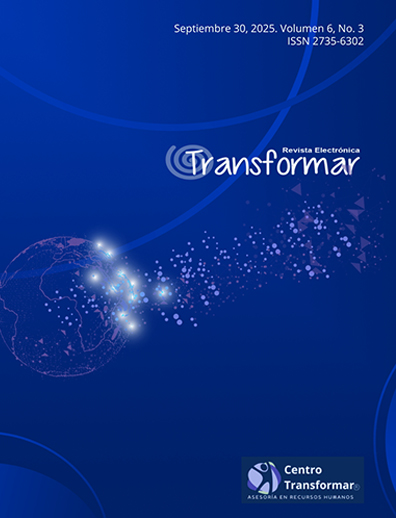Validation of the Questionnaire on Integration of Artificial Intelligence in Higher Education (Q-IAHE)
Palabras clave:
Artificial intelligence, Higher education, Educational innovation, Digital technology, Teaching methodsResumen
The growing integration of Artificial Intelligence (AI) in higher education underscores the need for validated instruments to assess perceptions and practices related to its use. In Latin America, however, such tools are still limited. This study validates the Questionnaire on Integration of Artificial Intelligence in Higher Education (Q-IAHE). A pilot study was carried out with a Chilean sample (n = 53), followed by a broader validation with a Mexican sample (n = 359). Analyses confirmed strong internal consistency (Cronbach’s alpha = .898) and a stable factorial structure across both groups, identifying four main dimensions of AI integration in learning and teaching. The results demonstrate that the Q-IAHE is a reliable and valid instrument for exploring AI adoption in higher education. Its application offers valuable insights for international research on educational innovation, pedagogy and digital transformation.
Citas
Boateng, G. O., Neilands, T. B., Frongillo, E. A., Melgar-Quiñonez, H. R., & Young, S. L. (2018). Best practices for developing and validating scales for health, social, and behavioral research: A primer. Frontiers in Public Health, 6, 149. https://doi.org/10.3389/fpubh.2018.00149
Chen, X. Xie,H., Zou, D., & Hwang, G.J. (2020). Application and theory gaps during the rise of Artificial Intelligence in Education. Computers and Education: Artificial Intelligence, 1, https://doi.org/10.1016/j.caeai.2020.100002
Creswell, J. W., & Creswell, J. D. (2018). Research design: Qualitative, quantitative, and mixed methods approaches (5th ed.). SAGE. https://spada.uns.ac.id/pluginfile.php/510378/mod_resource/content/1/creswell.pdf
Crompton, H., & Burke, D. (2023). Artificial intelligence in higher education: the state of the field. International Journal of Educational Technology in Higher Education, 20, 1-22. https://doi.org/10.1186/s41239-023-00392-8
DeVellis, R. F. (2017). Scale development: Theory and applications (4th ed.). SAGE.
Dignum, V. (2017). Responsible artificial intelligence: Designing AI for human values. ITU Journal: ICT Discoveries, Special Issue No. 1, 25.https://www.itu.int/dms_pub/itu-s/opb/journal/S-JOURNAL-ICTF.VOL1-2018-1-P01-PDF-E.pdf
ELLIS Institute. (2025). ELLIS Institute Finland. https://www.ellisinstitute.fi/about
European Commission. (2019). Ethics guidelines for trustworthy AI. Publications Office of the European Union. https://digital-strategy.ec.europa.eu/en/library/ethics-guidelines-trustworthy-ai
George, B., & Wooden, O. (2023). Managing the Strategic Transformation of Higher Education through Artificial Intelligence. Administrative Sciences. https://doi.org/10.3390/admsci13090196
Guo, S., Zheng, Y., & Zhai, X. (2024). Artificial intelligence in education research during 2013-2023: A review based on bibliometric analysis. Educ. Inf. Technol., 29, 16387-16409. https://doi.org/10.1007/s10639-024-12491-8
Hair, J. F., Black, W. C., Babin, B. J., & Anderson, R. E. (2019). Multivariate data analysis (8th ed.). Cengage. https://eli.johogo.com/Class/CCU/SEM/_Multivariate%20Data%20Analysis_Hair.pdf
Hinojo-Lucena, F., Aznar-Díaz, I., Cáceres-Reche, M., & Romero-Rodríguez, J. (2019). Artificial Intelligence in Higher Education: A Bibliometric Study on its Impact in the Scientific Literature. Education Sciences. https://doi.org/10.3390/EDUCSCI9010051
Holmes, W., Bialik, M., & Fadel, C. (2019). Artificial intelligence in education: Promises and implications for teaching and learning. Center for Curriculum Redesign. https://curriculumredesign.org/wp-content/uploads/AIED-Book-Excerpt-CCR.pdf
Hu, L. T., & Bentler, P. M. (1999). Cutoff criteria for fit indexes in covariance structure analysis: Conventional criteria versus new alternatives. Structural Equation Modeling, 6(1), 1–55. https://doi.org/10.1080/10705519909540118
IBM Corp. (2024). IBM SPSS Statistics for Windows (Version 29.0) [Computer software]. IBM Corp. https://www.ibm.com/support/pages/downloading-ibm-spss-statistics-29
ILIA (2025). Home 2025 – Índice Latinoamericano de Inteligencia Artificial. Tercera edición. https://indicelatam.cl/home-2025/#
Kavitha, K., Joshith, V., Rajeev, N., & S, A. (2024). Artificial Intelligence in Higher Education: A Bibliometric Approach. European Journal of Educational Research. https://doi.org/10.12973/eu-jer.13.3.1121
Kline, R. B. (2016). Principles and practice of structural equation modeling (4th ed.). Guilford Press. https://dl.icdst.org/pdfs/files4/befc0f8521c770249dd18726a917cf90.pdf
Miao, F., Holmes, W., Huang, R., & Zhang, H. (2021). AI and education: Guidance for policy-makers. UNESCO. https://doi.org/10.54675/PCSP7350
Ng, D. T. K., Wu, W., Leung, J. K. L., Chiu, T. K. F., & Chu, S. K. W. (2024). Design and validation of the AI Literacy Questionnaire: The affective, behavioural, cognitive and ethical approach. British Journal of Educational Technology, 55(3), 1082–1104. https://doi.org/10.1111/bjet.13411
OECD. (2021). Artificial intelligence in society. OECD Publishing.
Paek, S., & Kim, N. (2021). Analysis of Worldwide Research Trends on the Impact of Artificial Intelligence in Education. Sustainability. https://doi.org/10.3390/SU13147941
Popenici, S. A. D., & Kerr, S. (2017). Exploring the impact of artificial intelligence on teaching and learning in higher education. Research and Practice in Technology Enhanced Learning, 12(1), 22. https://doi.org/10.1186/s41039-017-0062-8
Tabachnick, B. G., & Fidell, L. S. (2019). Using multivariate statistics (7th ed.). Pearson. https://www.pearsonhighered.com/assets/preface/0/1/3/4/0134790545.pdf
Tavakol, M, Dennick ,R. (2011a). Post-examination analysis of objective tests. Med Teach, 33(6), 447-58 . https://doi.org/10.3109/0142159X.2011.564682
Tavakol, M., & Dennick, R. (2011b). Making sense of Cronbach’s alpha. International Journal of Medical Education, 2, 53–55. https://doi.org/10.5116/ijme.4dfb.8dfd
Tekinarslan, E., Gürer, M., & Akayoğlu, S. (2020). Web-Based Data Collection for Educational Research. , 152-172. https://doi.org/10.4018/978-1-7998-1173-2.ch008
UNESCO. (2023). AI and education: Guidance for policy-makers. UNESCO Publishing.
Vera, F. (2023a). Cuestionario sobre Integración de Inteligencia Artificial en la Educación (CIIAE). Red Internacional de Investigadores en Educación (REDIIE). https://rediie.cl/wp-content/uploads/CIIAE.pdf
Vera, F. (2023b). Faculty members’ perceptions of artificial intelligence in higher education: a comprehensive study. Transformar, 4(3), 55–68. https://revistatransformar.cl/index.php/transformar/article/view/103
Vera, F. (2024). Transforming Higher Education with Adaptive AI Driven-Learning: Challenges and Opportunities. Transformar, 5(2), 36–52. https://revistatransformar.cl/index.php/transformar/article/view/127
Xu, P., Dong, W., & Wang, C. (2022). Present Situation and Enlightenment of Artificial Intelligence Lifelong Education System in Singapore. Journal of Autonomous Intelligence. https://doi.org/10.32629/jai.v5i1.499
Yun, V., Ulang, N., & Husain, S. (2023). Measuring the Internal Consistency and Reliability of the Hierarchy of Controls in Preventing Infectious Diseases on Construction Sites: The Kuder-Richardson (KR-20) and Cronbach's Alpha. Journal of Advanced Research in Applied Sciences and Engineering Technology. https://doi.org/10.37934/araset.33.1.392405









